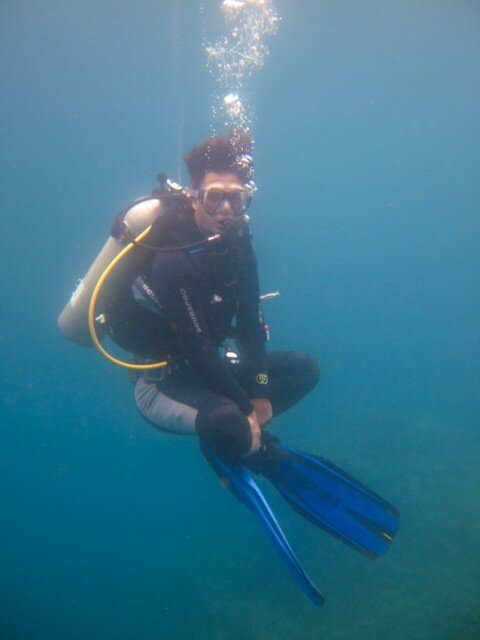Part 19: Indonesia: Hippocampus makes me a happy camper - The Round The World Travel Journal
Part 19: Indonesia: Hippocampus makes me a happy camper
Black sands beach, Bali
Feeling thoroughly cultured out, we bullied a local cheery taxi chappy into driving us through the mountains to the north westerly point of Bali island for a steal. The views were magnificent. Volcanoes reach upwards disappearing into the misty clouds and at their base scavenging bulldozers pillage the lava-rock. Freshwater lakes and rivers fill the valley troughs feeding tiny villages dotted along their edges.
Amed Black sands beach, Bali
Rice terraces sculpt the landscape into dramatic amphitheatres scattered with scarecrow surrender flags and bedraggled palm-leaf shacks. Temples protrude from bursting foliage and macaque monkeys spill out into the road clutching bananas and bracelets. Black sand gives way to brown sea with white outrigger canoes perched like water-boatmen on the water’s surface.
Beneath yet another gloomy grey cloud and misty mountain lies the seaside village of Pemuteran. The grey weather and typically rubbish strewn beach were of no odds to us. We came to explore what lies beneath the waves and our first foray into Balinese waters did not disappoint. I was anxious about diving again after suffering an excruciating reverse block and sinus squeeze in Vanuatu and knew that equalising on descent would be tricky.
The fact that it took me 10 minutes just to descend to 10 metres made little difference as we swam along a stunning vertical wall that dropped down to some 40 metres or so. An explosion of hard and soft corals, gorgonian sea fans, feather stars and anemones burst from the walls and reached out into the inky blue. The variety and abundance of fish swarming the drop off reef was unlike anything I had seen before. Then I heard the familiar ‘tap tap’ of a dive leader discovering something of interest for his clients. Still struggling with my ears, I pushed through a little pain barrier to reach his side by a huge pink gorgonian sea fan.
There it was, nestled within the arterial structure of the fan, within the tiny polyps, a minute dusky pink seahorse, perfectly formed despite being no bigger than 4mm in size.
He lolled to one side to display his distended pregnant belly and snuggled up to the polyps for cover. Realising that hiding is futile he uncurled his impossibly small tail and wafted across the fan to find darker corners in which to lurk. By this point I was so overcome with awe and blissful joy that I couldn’t care less about my ears or the leak in my mask or the weight belt chaffing my hip.
‘So what?’ you may say, ‘it is after all just a very small version of a bigger creature you can see in any aquarium’.
True, but like any diver, just as one might do when on safari, I have a wildlife wish list. To see some of the rare, wonderful and unique creatures of our world in their natural habitat is an honour and for me, the Pygmy Seahorse was my unicorn; the unrealistic and impossible addition to my wish list. Yet here I was, staring right at it, hippocampus denise.
One week later on the opposite side of the island on a similar drop off, a maroon gorgonian sea fan flaunted a 10mm long knobbly hippocampus bargibanti. Two sightings of two different species of pygmy seahorse in a matter of days! How will I ever be able to leave a country whose waters have been so kind to me? There are currently only nine species of pygmy seahorse known (5 of those species where discovered as recently as 2008/9) and they are almost exclusive to the waters around Indonesia and the Philippines. They vary in size with the largest reaching 25mm in length.
They are identical to their larger counterparts in shape, swimming motion and reproduction (the males gestate the young and give live birth). They are extremely sensitive to light and the obtrusive flashing of underwater photographer strobes can distress them greatly. Very little is known about them and worryingly their appearance has brought them much attention from divers, many of whom are selfishly insensitive in their greedy desires and can damage the delicate corals on which these tiny animals live, or more alarmingly the animal themselves. Sadly we witnessed this kind of rough and unnecessary manhandling.
Our dive master was so eager to show us the hippocampus bargibanti that he stuck a metal stick and inch from the seahorse through the gorgonian sea fan and wrenched it back so that we could get a better view. He then prodded the poor sad, flopping creature with his nail so that we could see it move. I do not blame him alone for his actions.
It is the responsibility of the dive centre owners (usually western) to educate their staff about the proper approach to sea life and it is the responsibility of divers the world over not to make local dive guides feel that they must take extreme action in order to please their customer. We run the risk of marginalising a delicate organism when we are only at the fringes of discovering it.
Forgive me for taking the opportunity to use our travel blog as a platform to plea for greater diver awareness, but it is something I feel deeply about. I may not be a very experienced diver but in the 13 or so years I have been suiting up and taking to the sea I have seen blunders and atrocities to the natural environment from those with 1 to 1000 dives under their belt.
The answer: if you’re a moron stay on dry land…preferably in doors.
Note ::: These articles were originally written by my wife Siobhan whilst we were travelling back in 2010 - 2011





